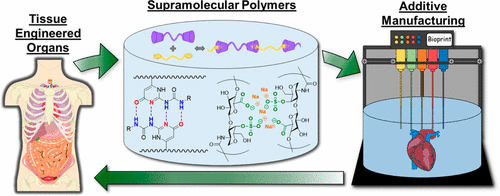当前位置:
X-MOL 学术
›
Biomacromolecules
›
论文详情
Our official English website, www.x-mol.net, welcomes your
feedback! (Note: you will need to create a separate account there.)
3D Printing Polymers with Supramolecular Functionality for Biological Applications
Biomacromolecules ( IF 5.5 ) Pub Date : 2017-08-22 00:00:00 , DOI: 10.1021/acs.biomac.7b00671 Allison M. Pekkanen 1, 2 , Ryan J. Mondschein 2, 3 , Christopher B. Williams 2, 4 , Timothy E. Long 2, 3
Biomacromolecules ( IF 5.5 ) Pub Date : 2017-08-22 00:00:00 , DOI: 10.1021/acs.biomac.7b00671 Allison M. Pekkanen 1, 2 , Ryan J. Mondschein 2, 3 , Christopher B. Williams 2, 4 , Timothy E. Long 2, 3
Affiliation

|
Supramolecular chemistry continues to experience widespread growth, as fine-tuned chemical structures lead to well-defined bulk materials. Previous literature described the roles of hydrogen bonding, ionic aggregation, guest/host interactions, and π–π stacking to tune mechanical, viscoelastic, and processing performance. The versatility of reversible interactions enables the more facile manufacturing of molded parts with tailored hierarchical structures such as tissue engineered scaffolds for biological applications. Recently, supramolecular polymers and additive manufacturing processes merged to provide parts with control of the molecular, macromolecular, and feature length scales. Additive manufacturing, or 3D printing, generates customizable constructs desirable for many applications, and the introduction of supramolecular interactions will potentially increase production speed, offer a tunable surface structure for controlling cell/scaffold interactions, and impart desired mechanical properties through reinforcing interlayer adhesion and introducing gradients or self-assembled structures. This review details the synthesis and characterization of supramolecular polymers suitable for additive manufacture and biomedical applications as well as the use of supramolecular polymers in additive manufacturing for drug delivery and complex tissue scaffold formation. The effect of supramolecular assembly and its dynamic behavior offers potential for controlling the anisotropy of the printed objects with exquisite geometrical control. The potential for supramolecular polymers to generate well-defined parts, hierarchical structures, and scaffolds with gradient properties/tuned surfaces provides an avenue for developing next-generation biomedical devices and tissue scaffolds.
中文翻译:

具有超分子功能的3D打印聚合物在生物学上的应用
超分子化学继续经历广泛的增长,因为微调的化学结构导致定义明确的块状材料。先前的文献描述了氢键,离子聚集,客体/主体相互作用以及π–π堆积来调节机械,粘弹性和加工性能的作用。可逆相互作用的多功能性使得能够更轻松地制造具有定制层次结构的模制零件,例如用于生物应用的组织工程支架。最近,超分子聚合物和增材制造工艺合并在一起,从而为零件提供了分子,大分子和特征长度尺度的控制。增材制造或3D打印可生成许多应用所需的可自定义结构,超分子相互作用的引入将潜在地提高生产速度,提供可调节的表面结构以控制细胞/支架相互作用,并通过增强层间粘附力和引入梯度或自组装结构来赋予所需的机械性能。这篇综述详述了适用于增材制造和生物医学应用的超分子聚合物的合成和表征,以及超分子聚合物在增材制造中用于药物输送和复杂组织支架形成的用途。超分子组装的效果及其动态行为为通过精细的几何控制来控制打印对象的各向异性提供了潜力。超分子聚合物产生明确定义的部分,层次结构,
更新日期:2017-08-22
中文翻译:

具有超分子功能的3D打印聚合物在生物学上的应用
超分子化学继续经历广泛的增长,因为微调的化学结构导致定义明确的块状材料。先前的文献描述了氢键,离子聚集,客体/主体相互作用以及π–π堆积来调节机械,粘弹性和加工性能的作用。可逆相互作用的多功能性使得能够更轻松地制造具有定制层次结构的模制零件,例如用于生物应用的组织工程支架。最近,超分子聚合物和增材制造工艺合并在一起,从而为零件提供了分子,大分子和特征长度尺度的控制。增材制造或3D打印可生成许多应用所需的可自定义结构,超分子相互作用的引入将潜在地提高生产速度,提供可调节的表面结构以控制细胞/支架相互作用,并通过增强层间粘附力和引入梯度或自组装结构来赋予所需的机械性能。这篇综述详述了适用于增材制造和生物医学应用的超分子聚合物的合成和表征,以及超分子聚合物在增材制造中用于药物输送和复杂组织支架形成的用途。超分子组装的效果及其动态行为为通过精细的几何控制来控制打印对象的各向异性提供了潜力。超分子聚合物产生明确定义的部分,层次结构,











































 京公网安备 11010802027423号
京公网安备 11010802027423号